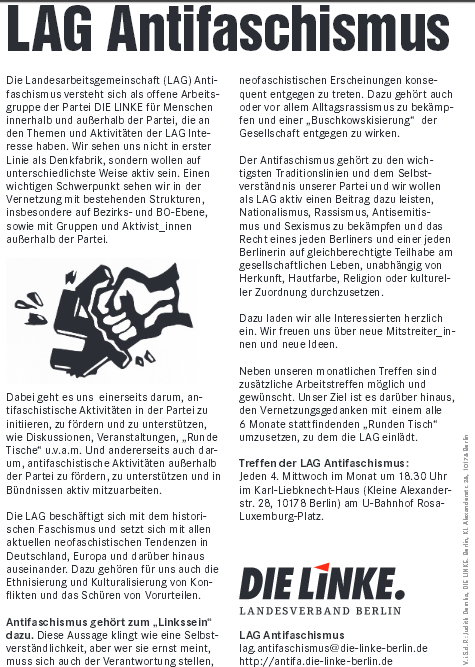In Post-246 (“Here Comes Bodo Ramelow“) I revisited my time in Germany in 2007, a subject about which I think I’ve rarely written on these pages. One of the things that impressed me there was the myriad of active political and quasi-political movements whirling around. If you read #246, you can see a slice of this.
I’ve been thinking more about the election result I mentioned in #246, in Thuringia (a German state formerly of East Germany), a place I passed through a time or two or three. The results of their recent state election:
* 28 seats were won by Die Linke (successor of the East German Communist Party) [31% of seats]
[…] [T]he Linke “neo-Communists” are a majority of [the new] ruling coalition, so it’s only fair that their guy, Bodo, becomes the formal leader.
“Die Linke” (English: The Left), which is the reformed Communist Party, won nearly one-in-three seats in this eastern-German state’s legislature. By the way, here is the top banner on the website of party’s Berlin chapter:

From website of the Linke party (die-linke-berlin.de), as of this writing
(It’s Herren Marx und Engels. These are life-size statues, put up during the Communist era, and still stand in central Berlin. I passed right by them many-a-time. They are in a big open square which is generally deserted.)
Those in the east voting for Linke are generally older people who actually lived as adults under the Communist East German government. Is this, then, a partial vindication of that system and its government?
Maybe. But hear this:
I passed through eastern German cities, towns, and villages at various times while over there. Political posters are often highly visible in Germany, including in small towns. The Linke posters across eastern Germany, I noted with interest, were adorned with pictures of smiling, white-haired retirees and suchlike, with bland promises about securing pensions and that kind of thing. Far from radical. I also observed the people in these places, the places where one-in-three may vote for this party. The average age seemed quite high; the average “radicalism”, quite low. The people I observed in these smaller towns reminded me of my own grandparents; they kept up their traditions (such as they were), took pride in their towns, maintained their households, and lived with quiet dignity, as older people do. It slowly dawned on me that this “communist” party was actually kept afloat by…conservatives.
Maybe this is a window into the nature of political thought itself. These east(ern) German voters in their 50s, 60s, 70s who are voting Linke into the 2010s are not “left-wing extremists”. Suggesting so is a bit silly. They are basically conservative people.
This leads me to ask: What is a conservative? If we hold all else equal,
maybe a conservative is one who wants [thinks he wants] whatever system existed, say, forty years ago (or some such number of years ago; the recent past), regardless of what that system was, whether it was considered left or right or whatever at the time.
The Linke party itself is actually radical at its core, at its top, and at its (youth) fringes. (I concluded this at the time.) Its eastern voter base may be ‘conservative’, but West Germans who embrace this party may have to be called radicals.
Thus I realized that we can speak of a secondary base of this party — smaller but noisier — in the form of belligerently left-wing youth p
rone to masked-mayhem and violence, the type that Europeans will know as “Antifas”, and their less-belligerent sympaticos. Their material was highly visible in most parts of Berlin (they don’t call it “Red Berlin” for nothing). But not in all parts. “Ganz im Osten” (as I called it — “in the deep east”) of that city they faced hostile territory and they knew it, or so I gathered. This territory belonged to the infamous Rechtsradikaler (radical right). I noticed this difference in political “turf” starkly over one particular night (and a long night it was). I, along with G.S., an American friend also studying in Germany at the time, walked clear across most of Berlin. It was ambitious, but we did it. (We started near Ostkreuz or Lichtenberg [which is definitely “deeply east”] at 10 PM or so, and ended west of the Westkreuz train station — on foot the whole way. It took us over eight hours. I don’t know whose idea this was, but it sounds like something I’d propose. We arrived past dawn at his apartment in the west [where I was staying for the time being while I sorted out a new place to live].)
Anyway, about the Linke Party. I think we can say Linke is “two parties” that have joined together for convenience’s sake — one is a party for nostalgic ‘conservative’ east-Germans in or near retirement age (see above), and the other a party of and for the angrily radical left. Without the former, the party gets no voters and is stuck in the electoral ghetto (Linke has almost no representation anywhere in West Germany due to the 5%-threshold rule). Without the latter, the party lacks for energy, sags under the weight of political lethargy, and may not have survived to the present day.
This was my opinion as an outside observer.
Here is an official document of the party I’ve been discussing, Die Linke (or, in English, “The Left”):

An official document of the party Die Linke in Germany,
successor to the East German Communist Party
The leaflet is all about “fighting fascism” (whatever that means in this day and age), which is a major theme of Linke material, just as it was for the Communist East German ruling party. As a matter of fact, the Communist Party, in its day, called the Berlin Wall the “Anti-Fascist Protective Barrier”(antifaschistischer Schutzwall). Likewise, one of the “Antifa” slogans I recall from Germany is: “Deutsche Polizisten schützen die Faschisten” (German police protect the fascists).


